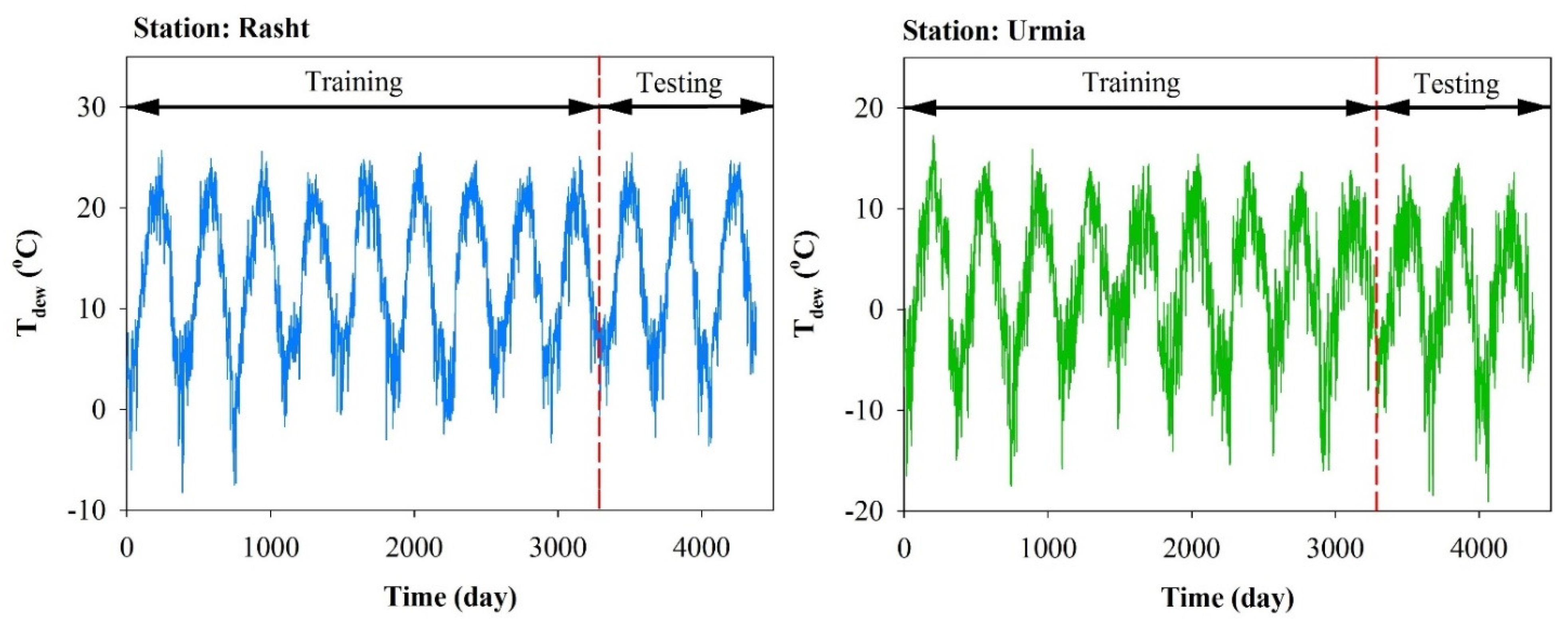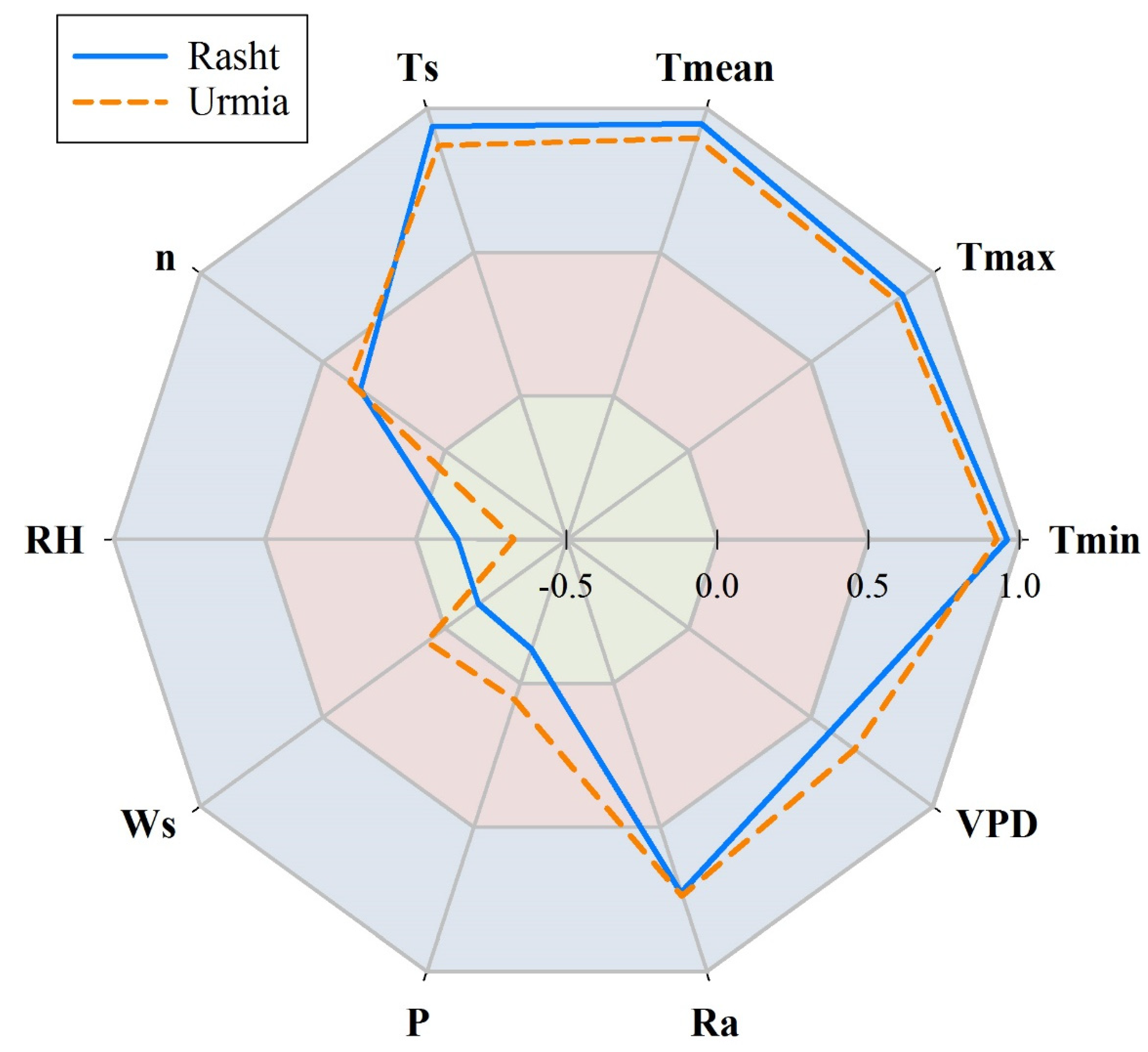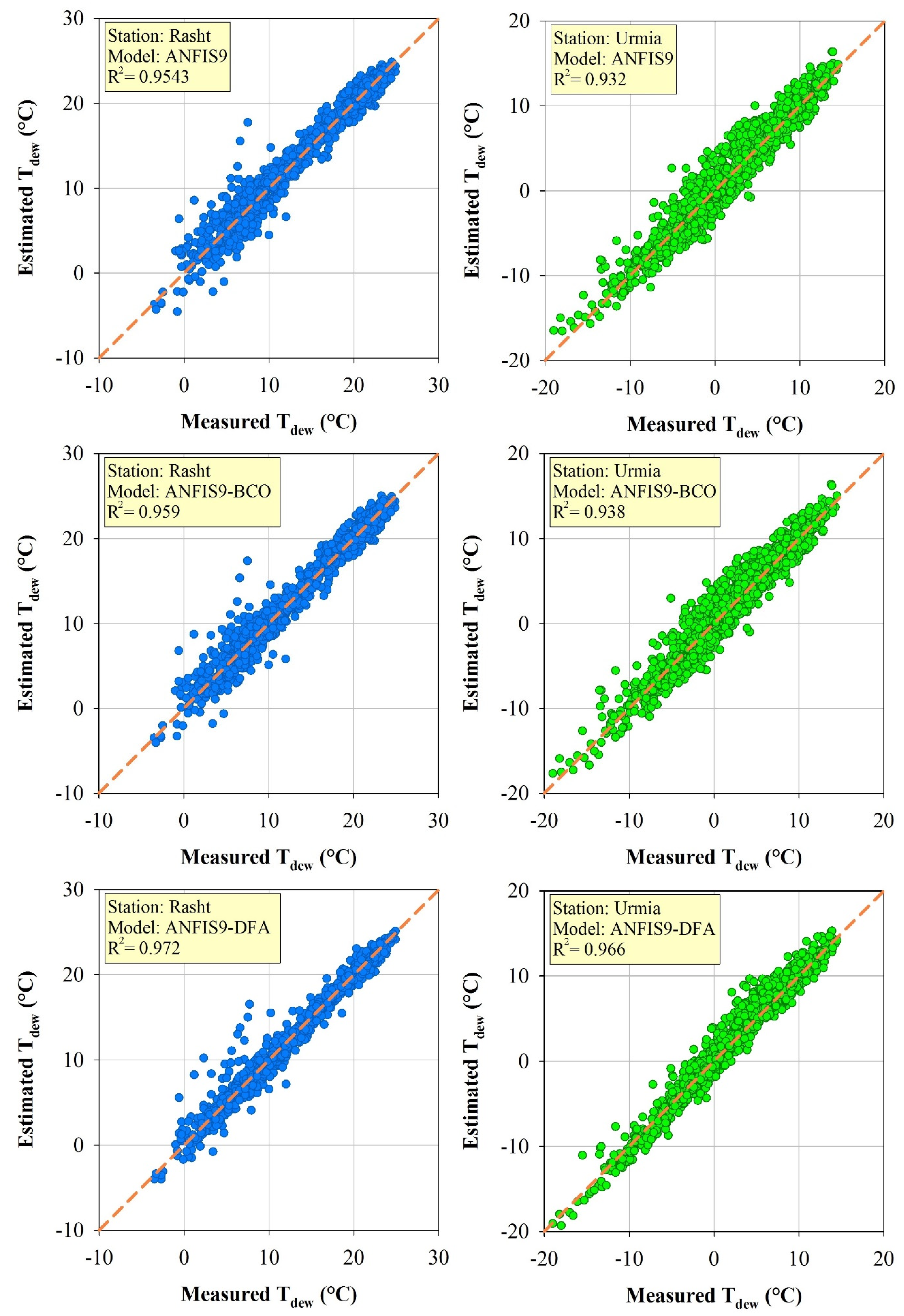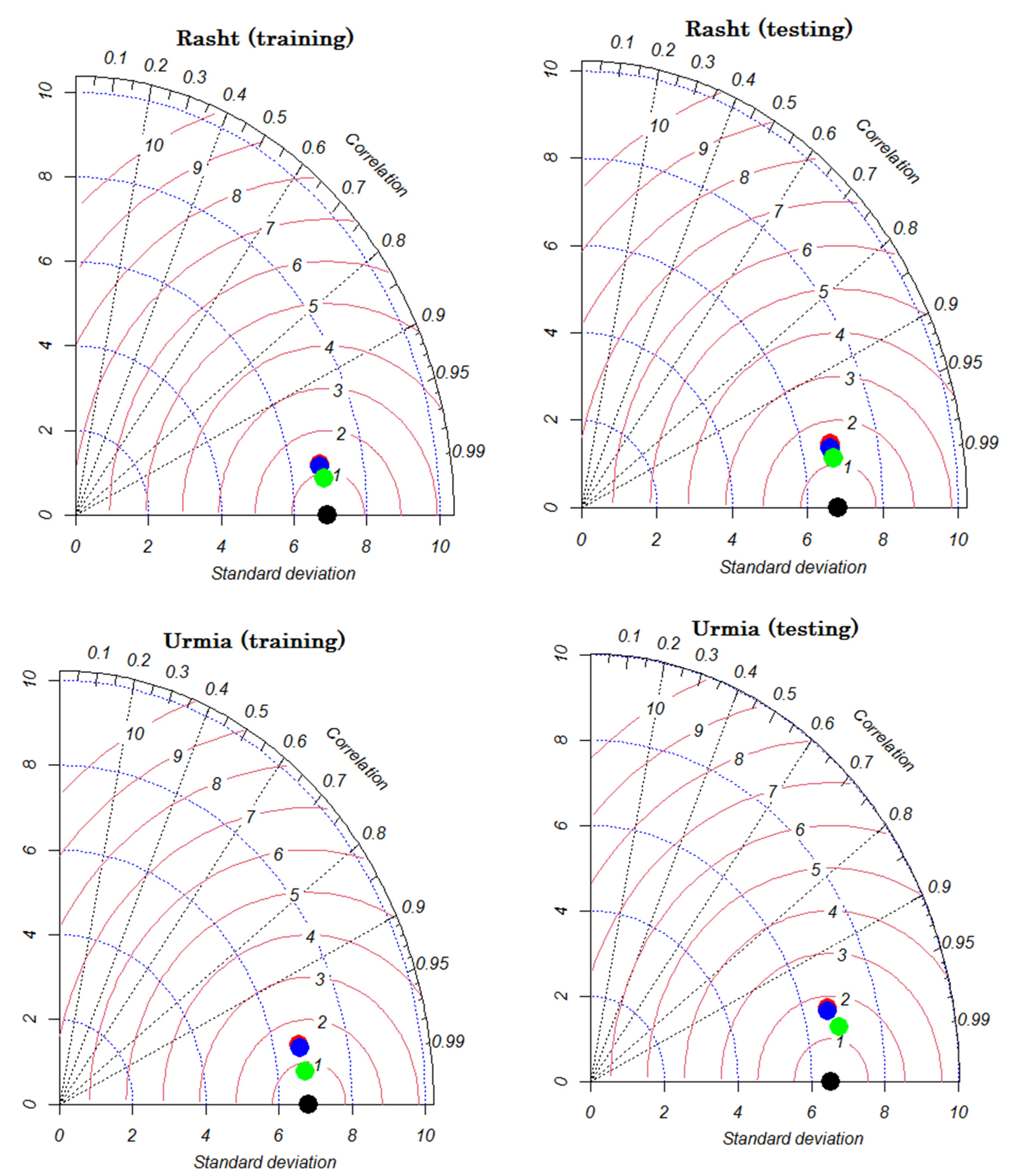Establishing Coupled Models for Estimating Daily Dew Point Temperature Using Nature-Inspired Optimization Algorithms
Abstract
:1. Introduction
2. Materials and Methods
2.1. Study Region and Data Used
2.2. Models Used
2.2.1. Adaptive Neuro-Fuzzy Inference System (ANFIS)
2.2.2. Bee Colony Optimization (BCO)
2.2.3. Dragonfly Algorithm (DFA)
2.3. Models’ Development
3. Error Metrics Used to Evaluate the Models’ Performance
4. Results and Discussions
4.1. Performance Investigation of the Classic and Hybrid Models Proposed
4.2. Performance Comparison of Classic and Coupled Models Proposed
5. Conclusions
Author Contributions
Funding
Data Availability Statement
Conflicts of Interest
References
- Mohammadi, K.; Shamshirband, S.; Petković, D.; Yee, P.L.; Mansor, Z. Using ANFIS for selection of more relevant parameters to predict dew point temperature. Appl. Therm. Eng. 2016, 96, 311–319. [Google Scholar] [CrossRef]
- Lawrence, M.G. The relationship between relative humidity and the dewpoint temperature in moist air: A simple conversion and applications. Bull. Am. Meteorol. Soc. 2005, 86, 225–234. [Google Scholar] [CrossRef]
- Emmel, C.; Knippertz, P.; Schulz, O. Climatology of convective density currents in the southern foothills of the Atlas Mountains. J. Geophys. Res. Atmos. 2010, 115. [Google Scholar] [CrossRef]
- Katul, G.G.; Oren, R.; Manzoni, S.; Higgins, C.; Parlange, M.B. Evapotranspiration: A process driving mass transport and energy exchange in the soil-plant-atmosphere-climate system. Rev. Geophys. 2012, 50. [Google Scholar] [CrossRef] [Green Version]
- Feld, S.I.; Cristea, N.C.; Lundquist, J.D. Representing atmospheric moisture content along mountain slopes: Examination using distributed sensors in the Sierra Nevada, California. Water Resour. Res. 2013, 49, 4424–4441. [Google Scholar] [CrossRef]
- Mehdizadeh, S.; Behmanesh, J.; Khalili, K. Application of gene expression programming to predict daily dew point temperature. Appl. Therm. Eng. 2017, 112, 1091–1107. [Google Scholar] [CrossRef]
- Hubbard, K.G.; Mahmood, R.; Carlson, C. Estimating daily dew point temperature for the northern Great Plains using maximum and minimum temperature. Agron. J. 2003, 95, 323–328. [Google Scholar] [CrossRef]
- Agam, N.; Berliner, P.R. Dew formation and water vapor adsorption in semi-arid environments—A review. J. Arid Environ. 2006, 65, 572–590. [Google Scholar] [CrossRef]
- Drezner, T.D. An analysis of winter temperature and dew point under the canopy of a common Sonoran Desert nurse and the implications for positive plant interactions. J. Arid Environ. 2007, 69, 554–568. [Google Scholar] [CrossRef]
- Shank, D.B.; Hoogenboom, G.; McClendon, R.W. Dewpoint temperature prediction using artificial neural networks. J. Appl. Meteorol. Climatol. 2008, 47, 1757–1769. [Google Scholar] [CrossRef]
- Mohammadi, K.; Shamshirband, S.; Motamedi, S.; Petković, D.; Hashim, R.; Gocic, M. Extreme learning machine based prediction of daily dew point temperature. Comput. Electron. Agric. 2015, 117, 214–225. [Google Scholar] [CrossRef]
- Dong, J.; Wu, L.; Liu, X.; Li, Z.; Gao, Y.; Zhang, Y.; Yang, Q. Estimation of daily dew point temperature by using bat algorithm optimization based extreme learning machine. Appl. Therm. Eng. 2020, 165, 114569. [Google Scholar] [CrossRef]
- Zounemat-Kermani, M. Hourly predictive Levenberg-Marquardt ANN and multi linear regression models for predicting of dew point temperature. Meteorol. Atmos. Phys. 2012, 117, 181–192. [Google Scholar] [CrossRef]
- Nadig, K.; Potter, W.; Hoogenboom, G.; McClendon, R. Comparison of individual and combined ANN models for prediction of air and dew point temperature. Appl. Intell. 2013, 39, 354–366. [Google Scholar] [CrossRef]
- Kim, S.; Singh, V.P.; Lee, C.J.; Seo, Y. Modeling the physical dynamics of daily dew point temperature using soft computing techniques. KSCE J. Civ. Eng. 2015, 19, 1930–1940. [Google Scholar] [CrossRef]
- Baghban, A.; Bahadori, M.; Rozyn, J.; Lee, M.; Abbas, A.; Bahadori, A.; Rahimali, A. Estimation of air dew point temperature using computational intelligence schemes. Appl. Therm. Eng. 2016, 93, 1043–1052. [Google Scholar] [CrossRef]
- Amirmojahedi, M.; Mohammadi, K.; Shamshirband, S.; Seyed Danesh, A.; Mostafaeipour, A.; Kamsin, A. A hybrid computational intelligence method for predicting dew point temperature. Environ. Earth Sci. 2016, 75, 415. [Google Scholar] [CrossRef]
- Qasem, S.N.; Samadianfard, S.; Nahand, H.S.; Mosavi, A.; Shamshirband, S.; Chau, K.W. Estimating daily dew point temperature using machine learning algorithms. Water 2019, 11, 582. [Google Scholar] [CrossRef] [Green Version]
- Arikan, B.B.; Jiechen, L.; Sabbah, I.I.D.; Ewees, A.; Homsi, R.; Sulaiman, S.O. Dew Point Time Series Forecasting at the North Dakota. Knowledge-Based Eng. Sci. 2021, 2, 24–34. [Google Scholar] [CrossRef]
- Golizadeh Akhlaghi, Y.; Aslansefat, K.; Zhao, X.; Sadati, S.; Badiei, A.; Xiao, X.; Shittu, S.; Fan, Y.; Ma, X. Hourly performance forecast of a dew point cooler using explainable Artificial Intelligence and evolutionary optimisations by 2050. Appl. Energy 2021, 281, 116062. [Google Scholar] [CrossRef]
- Alizamir, M.; Kim, S.; Kisi, O.; Zounemat-Kermani, M. Deep echo state network: A novel machine learning approach to model dew point temperature using meteorological variables. Hydrol. Sci. J. 2020, 65, 1173–1190. [Google Scholar] [CrossRef]
- Mehr, A.D.; Tur, R.; Çalışkan, C.; Tas, E. A Novel Fuzzy Random Forest Model for Meteorological Drought Classification and Prediction in Ungauged Catchments. Pure Appl. Geophys. 2020, 177, 5993–6006. [Google Scholar] [CrossRef]
- Noori, R.; Safavi, S.; Nateghi Shahrokni, S.A. A reduced-order adaptive neuro-fuzzy inference system model as a software sensor for rapid estimation of five-day biochemical oxygen demand. J. Hydrol. 2013, 495, 175–185. [Google Scholar] [CrossRef]
- Noori, R.; Karbassi, A.; Farokhnia, A.; Dehghani, M. Predicting the longitudinal dispersion coefficient using support vector machine and adaptive neuro-fuzzy inference system techniques. Environ. Eng. Sci. 2009, 26, 1503–1510. [Google Scholar] [CrossRef]
- Noori, R.; Deng, Z.; Kiaghadi, A.; Kachoosangi, F.T. How Reliable Are ANN, ANFIS, and SVM Techniques for Predicting Longitudinal Dispersion Coefficient in Natural Rivers? J. Hydraul. Eng. 2016, 142, 04015039. [Google Scholar] [CrossRef]
- Hanoon, M.S.; Ahmed, A.N.; Zaini, N.; Razzaq, A.; Kumar, P.; Sherif, M.; Sefelnasr, A.; El-Shafie, A. Developing machine learning algorithms for meteorological temperature and humidity forecasting at Terengganu state in Malaysia. Sci. Rep. 2021, 11, 18935. [Google Scholar] [CrossRef] [PubMed]
- Emamgholizadeh, S.; Mohammadi, B. New hybrid nature-based algorithm to integration support vector machine for prediction of soil cation exchange capacity. Soft Comput. 2021, 25, 13451–13464. [Google Scholar] [CrossRef]
- Mohammadi, B.; Guan, Y.; Moazenzadeh, R.; Safari, M.J.S. Implementation of hybrid particle swarm optimization-differential evolution algorithms coupled with multi-layer perceptron for suspended sediment load estimation. Catena 2021, 198, 105024. [Google Scholar] [CrossRef]
- Aghelpour, P.; Mohammadi, B.; Mehdizadeh, S.; Bahrami-Pichaghchi, H.; Duan, Z. A novel hybrid dragonfly optimization algorithm for agricultural drought prediction. Stoch. Environ. Res. Risk Assess. 2021, 35, 2459–2477. [Google Scholar] [CrossRef]
- Ahmadi, F.; Mehdizadeh, S.; Mohammadi, B. Development of Bio-Inspired and Wavelet-Based Hybrid Models for Reconnaissance Drought Index Modeling. Water Resour. Manag. 2021, 35, 4127–4147. [Google Scholar] [CrossRef]
- Mohammadi, B.; Guan, Y.; Aghelpour, P.; Emamgholizadeh, S.; Zolá, R.P.; Zhang, D. Simulation of Titicaca Lake Water Level Fluctuations Using Hybrid Machine Learning Technique Integrated with Grey Wolf Optimizer Algorithm. Water 2020, 12, 3015. [Google Scholar] [CrossRef]
- Jang, J.S.R. ANFIS: Adaptive-Network-Based Fuzzy Inference System. IEEE Trans. Syst. Man Cybern. 1993, 23, 665–685. [Google Scholar] [CrossRef]
- Kisi, O.; Demir, V.; Kim, S. Estimation of Long-Term Monthly Temperatures by Three Different Adaptive Neuro-Fuzzy Approaches Using Geographical Inputs. J. Irrig. Drain. Eng. 2017, 143, 105024. [Google Scholar] [CrossRef]
- Azad, A.; Farzin, S.; Kashi, H.; Sanikhani, H.; Karami, H.; Kisi, O. Prediction of river flow using hybrid neuro-fuzzy models. Arab. J. Geosci. 2018, 11, 718. [Google Scholar] [CrossRef]
- Akay, B.; Karaboga, D. A modified Artificial Bee Colony algorithm for real-parameter optimization. Inf. Sci. 2012, 192, 120–142. [Google Scholar] [CrossRef]
- Seeley, T.D. The Wisdom of the Hive: The Social Physiology of Honey Bee Colonies; Harvard University Press: Cambridge, MA, USA, 2009; Volume 277, p. 291. [Google Scholar]
- Mirjalili, S. Dragonfly algorithm: A new meta-heuristic optimization technique for solving single-objective, discrete, and multi-objective problems. Neural Comput. Appl. 2016, 27, 1053–1073. [Google Scholar] [CrossRef]
- Mehdizadeh, S. Assessing the potential of data-driven models for estimation of long-term monthly temperatures. Comput. Electron. Agric. 2018, 144, 114–125. [Google Scholar] [CrossRef]
- Mehdizadeh, S. Using AR, MA, and ARMA Time Series Models to Improve the Performance of MARS and KNN Approaches in Monthly Precipitation Modeling under Limited Climatic Data. Water Resour. Manag. 2020, 34, 263–282. [Google Scholar] [CrossRef]






| Station | Variables | Minimum | Maximum | Mean | Standard Deviation |
|---|---|---|---|---|---|
| Rasht | Tdew (°C) | −8.2 | 25.5 | 13.1 | 6.9 |
| Tmin (°C) | −12.8 | 27.6 | 12.8 | 7.5 | |
| Tmax (°C) | −1.4 | 38.6 | 21.2 | 8.4 | |
| Tmean (°C) | −5.2 | 32.1 | 17.0 | 7.7 | |
| Ts (°C) | 0.0 | 40.2 | 18.9 | 8.9 | |
| n (hrs) | 0.0 | 13.4 | 4.8 | 4.2 | |
| RH (%) | 16.0 | 100.0 | 81.4 | 9.8 | |
| Ws (m s−1) | 0.0 | 9.0 | 1.6 | 1.0 | |
| P (mm) | 0.0 | 136.0 | 3.4 | 10.4 | |
| Ra (MJ m−2 day−1) | 15.2 | 41.8 | 29.2 | 9.5 | |
| VPD (KPa) | 0.0 | 2.5 | 0.5 | 0.4 | |
| Urmia | Tdew (°C) | −19.0 | 17.1 | 2.6 | 6.8 |
| Tmin (°C) | −18.2 | 23.7 | 5.1 | 8.4 | |
| Tmax (°C) | −7.2 | 39.9 | 18.8 | 10.7 | |
| Tmean (°C) | −12.4 | 29.3 | 12.0 | 9.4 | |
| Ts (°C) | −7.7 | 39.0 | 15.2 | 11.7 | |
| n (hrs) | 0.0 | 14.5 | 8.1 | 3.9 | |
| RH (%) | 22.0 | 99.5 | 58.6 | 15.5 | |
| Ws (m s−1) | 0.1 | 8.4 | 2.7 | 0.9 | |
| P (mm) | 0.0 | 55.0 | 0.8 | 3.4 | |
| Ra (MJ m−2 day−1) | 15.0 | 41.8 | 29.1 | 9.6 | |
| VPD (KPa) | 0.0 | 3.1 | 0.9 | 0.7 |
| Parameter | Values |
|---|---|
| Epoch | 1000 |
| Initial step size | 0.01 |
| Step size decrease | 0.9 |
| Step size increase | 1.1 |
| Error goal | 0 |
| Models | Inputs | Output |
|---|---|---|
| ANFIS1, ANFIS1-BCO, ANFIS1-DFA | Tmin | Tdew |
| ANFIS2, ANFIS2-BCO, ANFIS2-DFA | Ra | Tdew |
| ANFIS3, ANFIS3-BCO, ANFIS3-DFA | VPD | Tdew |
| ANFIS4, ANFIS4-BCO, ANFIS4-DFA | n | Tdew |
| ANFIS5, ANFIS5-BCO, ANFIS5-DFA | RH | Tdew |
| ANFIS6, ANFIS6-BCO, ANFIS6-DFA | Tmin, Ra | Tdew |
| ANFIS7, ANFIS7-BCO, ANFIS7-DFA | Tmin, Ra, VPD | Tdew |
| ANFIS8, ANFIS8-BCO, ANFIS8-DFA | Tmin, Ra, VPD, n | Tdew |
| ANFIS9, ANFIS9-BCO, ANFIS9-DFA | Tmin, Ra, VPD, n, RH | Tdew |
| Models | Training | Testing | ||||||
|---|---|---|---|---|---|---|---|---|
| RMSE (°C) | RRMSE | MAE (°C) | R2 | RMSE (°C) | RRMSE | MAE (°C) | R2 | |
| ANFIS1 | 1.888 | 0.145 | 1.347 | 0.926 | 1.912 | 0.144 | 1.406 | 0.922 |
| ANFIS2 | 4.787 | 0.367 | 4.014 | 0.522 | 4.571 | 0.343 | 3.814 | 0.553 |
| ANFIS3 | 5.307 | 0.407 | 3.988 | 0.413 | 5.066 | 0.380 | 3.858 | 0.449 |
| ANFIS4 | 6.385 | 0.489 | 5.335 | 0.150 | 6.185 | 0.464 | 5.154 | 0.179 |
| ANFIS5 | 6.784 | 0.520 | 5.735 | 0.045 | 6.618 | 0.497 | 5.680 | 0.060 |
| ANFIS6 | 1.888 | 0.145 | 1.346 | 0.926 | 1.911 | 0.143 | 1.405 | 0.923 |
| ANFIS7 | 1.816 | 0.139 | 1.355 | 0.931 | 1.920 | 0.144 | 1.486 | 0.922 |
| ANFIS8 | 1.606 | 0.123 | 1.183 | 0.946 | 1.698 | 0.127 | 1.296 | 0.939 |
| ANFIS9 | 1.221 | 0.094 | 0.927 | 0.969 | 1.465 | 0.110 | 1.073 | 0.954 |
| ANFIS1-BCO | 1.856 | 0.142 | 1.309 | 0.928 | 1.890 | 0.142 | 1.368 | 0.924 |
| ANFIS2-BCO | 4.781 | 0.366 | 4.010 | 0.524 | 4.568 | 0.343 | 3.815 | 0.553 |
| ANFIS3-BCO | 5.275 | 0.404 | 3.966 | 0.420 | 5.037 | 0.378 | 3.825 | 0.455 |
| ANFIS4-BCO | 6.369 | 0.488 | 5.311 | 0.155 | 6.169 | 0.463 | 5.141 | 0.183 |
| ANFIS5-BCO | 6.617 | 0.507 | 5.608 | 0.088 | 6.468 | 0.486 | 5.528 | 0.102 |
| ANFIS6-BCO | 1.822 | 0.140 | 1.290 | 0.931 | 1.849 | 0.139 | 1.354 | 0.927 |
| ANFIS7-BCO | 1.689 | 0.129 | 1.221 | 0.941 | 1.786 | 0.134 | 1.336 | 0.932 |
| ANFIS8-BCO | 1.562 | 0.120 | 1.142 | 0.949 | 1.658 | 0.124 | 1.252 | 0.942 |
| ANFIS9-BCO | 1.158 | 0.089 | 0.869 | 0.972 | 1.387 | 0.104 | 1.003 | 0.959 |
| ANFIS1-DFA | 1.848 | 0.142 | 1.298 | 0.929 | 1.877 | 0.141 | 1.352 | 0.925 |
| ANFIS2-DFA | 4.773 | 0.366 | 4.005 | 0.525 | 4.564 | 0.343 | 3.816 | 0.554 |
| ANFIS3-DFA | 5.212 | 0.400 | 3.928 | 0.434 | 5.002 | 0.376 | 3.794 | 0.463 |
| ANFIS4-DFA | 6.352 | 0.487 | 5.284 | 0.159 | 6.165 | 0.463 | 5.132 | 0.184 |
| ANFIS5-DFA | 6.452 | 0.495 | 5.464 | 0.132 | 6.358 | 0.477 | 5.404 | 0.132 |
| ANFIS6-DFA | 1.690 | 0.130 | 1.231 | 0.940 | 1.688 | 0.127 | 1.285 | 0.939 |
| ANFIS7-DFA | 1.603 | 0.123 | 1.188 | 0.946 | 1.752 | 0.132 | 1.329 | 0.935 |
| ANFIS8-DFA | 1.410 | 0.108 | 1.060 | 0.959 | 1.590 | 0.119 | 1.183 | 0.947 |
| ANFIS9-DFA | 0.877 | 0.067 | 0.645 | 0.984 | 1.146 | 0.086 | 0.747 | 0.972 |
| Models | Training | Testing | ||||||
|---|---|---|---|---|---|---|---|---|
| RMSE (°C) | RRMSE | MAE (°C) | R2 | RMSE (°C) | RRMSE | MAE (°C) | R2 | |
| ANFIS1 | 2.424 | 0.857 | 1.905 | 0.874 | 2.853 | 1.580 | 2.223 | 0.840 |
| ANFIS2 | 4.563 | 1.613 | 3.703 | 0.553 | 4.569 | 2.530 | 3.640 | 0.538 |
| ANFIS3 | 4.605 | 1.628 | 3.698 | 0.544 | 4.590 | 2.542 | 3.618 | 0.555 |
| ANFIS4 | 5.860 | 2.072 | 4.677 | 0.262 | 5.766 | 3.193 | 4.556 | 0.256 |
| ANFIS5 | 6.434 | 2.275 | 5.328 | 0.112 | 6.331 | 3.506 | 5.066 | 0.128 |
| ANFIS6 | 2.413 | 0.853 | 1.895 | 0.875 | 2.846 | 1.576 | 2.214 | 0.840 |
| ANFIS7 | 2.060 | 0.728 | 1.575 | 0.909 | 2.322 | 1.286 | 1.750 | 0.883 |
| ANFIS8 | 2.035 | 0.719 | 1.557 | 0.911 | 2.290 | 1.268 | 1.747 | 0.886 |
| ANFIS9 | 1.419 | 0.502 | 1.099 | 0.957 | 1.763 | 0.977 | 1.358 | 0.933 |
| ANFIS1-BCO | 2.419 | 0.855 | 1.896 | 0.874 | 2.847 | 1.576 | 2.216 | 0.841 |
| ANFIS2-BCO | 4.544 | 1.607 | 3.694 | 0.556 | 4.565 | 2.528 | 3.639 | 0.538 |
| ANFIS3-BCO | 4.591 | 1.623 | 3.704 | 0.547 | 4.568 | 2.530 | 3.608 | 0.559 |
| ANFIS4-BCO | 5.807 | 2.053 | 4.604 | 0.275 | 5.735 | 3.176 | 4.512 | 0.267 |
| ANFIS5-BCO | 6.302 | 2.228 | 5.173 | 0.147 | 6.230 | 3.450 | 4.952 | 0.135 |
| ANFIS6-BCO | 2.377 | 0.840 | 1.853 | 0.879 | 2.834 | 1.569 | 2.183 | 0.841 |
| ANFIS7-BCO | 2.044 | 0.723 | 1.558 | 0.910 | 2.307 | 1.278 | 1.742 | 0.885 |
| ANFIS8-BCO | 1.996 | 0.706 | 1.519 | 0.914 | 2.278 | 1.261 | 1.722 | 0.888 |
| ANFIS9-BCO | 1.360 | 0.481 | 1.033 | 0.960 | 1.681 | 0.931 | 1.289 | 0.938 |
| ANFIS1-DFA | 2.413 | 0.853 | 1.891 | 0.875 | 2.846 | 1.576 | 2.215 | 0.840 |
| ANFIS2-DFA | 4.523 | 1.599 | 3.686 | 0.560 | 4.544 | 2.516 | 3.638 | 0.543 |
| ANFIS3-DFA | 4.558 | 1.612 | 3.669 | 0.554 | 4.546 | 2.517 | 3.582 | 0.558 |
| ANFIS4-DFA | 5.766 | 2.039 | 4.569 | 0.286 | 5.735 | 3.176 | 4.512 | 0.269 |
| ANFIS5-DFA | 6.260 | 2.214 | 5.130 | 0.158 | 6.201 | 3.434 | 4.917 | 0.136 |
| ANFIS6-DFA | 2.354 | 0.832 | 1.844 | 0.881 | 2.840 | 1.573 | 2.197 | 0.841 |
| ANFIS7-DFA | 1.907 | 0.674 | 1.448 | 0.922 | 2.215 | 1.227 | 1.672 | 0.892 |
| ANFIS8-DFA | 1.827 | 0.646 | 1.386 | 0.928 | 2.152 | 1.192 | 1.623 | 0.899 |
| ANFIS9-DFA | 0.778 | 0.275 | 0.604 | 0.987 | 1.329 | 0.736 | 1.002 | 0.966 |
Publisher’s Note: MDPI stays neutral with regard to jurisdictional claims in published maps and institutional affiliations. |
© 2022 by the authors. Licensee MDPI, Basel, Switzerland. This article is an open access article distributed under the terms and conditions of the Creative Commons Attribution (CC BY) license (https://creativecommons.org/licenses/by/4.0/).
Share and Cite
Mehdizadeh, S.; Mohammadi, B.; Ahmadi, F. Establishing Coupled Models for Estimating Daily Dew Point Temperature Using Nature-Inspired Optimization Algorithms. Hydrology 2022, 9, 9. https://doi.org/10.3390/hydrology9010009
Mehdizadeh S, Mohammadi B, Ahmadi F. Establishing Coupled Models for Estimating Daily Dew Point Temperature Using Nature-Inspired Optimization Algorithms. Hydrology. 2022; 9(1):9. https://doi.org/10.3390/hydrology9010009
Chicago/Turabian StyleMehdizadeh, Saeid, Babak Mohammadi, and Farshad Ahmadi. 2022. "Establishing Coupled Models for Estimating Daily Dew Point Temperature Using Nature-Inspired Optimization Algorithms" Hydrology 9, no. 1: 9. https://doi.org/10.3390/hydrology9010009
APA StyleMehdizadeh, S., Mohammadi, B., & Ahmadi, F. (2022). Establishing Coupled Models for Estimating Daily Dew Point Temperature Using Nature-Inspired Optimization Algorithms. Hydrology, 9(1), 9. https://doi.org/10.3390/hydrology9010009







